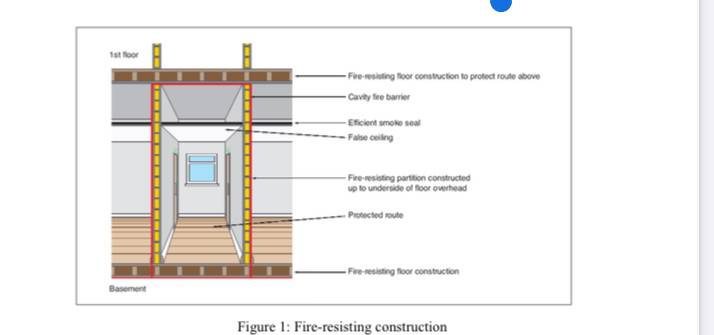6. STAIRS
The means of communication between various floors is offered by various structures such as stairs, lifts, ramps, ladders, escalators.
STAIR: A stair is a series of steps arranged in a manner as to connect different floors of a building. Stairs are designed to provide an easy and quick access to different floors.
• A staircase is an enclosure which contains the complete stairway.
• In a residential house stairs may be provided near the entrance.
• In a public building, stairs must be from main entrance and located centrally.
STAIRCASE: Room of a building where stair is located. STAIRWAY: Space occupied by the stair. TECHNICAL TERMS
1. BALUSTER: Vertical member which is fixed between stairway and horizontal to provide support to hand rail.
2. BALUSTRADE: Combined framework of baluster and hand rail.
3. STRING: Inclined member of a stair which supports ends of steps. They are of two
types, (i) cut/open string, (ii) closed/housed string.
• In open string, upper edge is cut away to receive the ends of steps.
• In closed string, the ends of steps are layed between straight and parallel edges of
the string.
4. FLIGHT : Unbroken series of steps between the landings.
5. GOING: horizontal distance between faces of two consecutive risers.
6. HANDRAIL: inclined rail over the string. Generally it is moulded. It serves as a guard
rail. It is provided at a convenient height so as to give grasp to hand during ascent and
descent.
7. HEAD ROOM: vertical distance between nosingsof one flight and the bottom of flight
immediately above is called head room.
8. LANDING: horizontal platform between two flights of a stair. A landing facilitates
change of direction and provides an opportunity to take rest.
9. NEWEL POST: vertical member placed at ends of flights to connect ends of string and
hand rail.
10. NOSING: projection part of tread beyond face of riser.
11. LINE OF NOSING: imaginary line parallel to strings and tangential to nosings. The
underface of hand rail should coincide with line of nosing.
12. PITCH: angle of inclination of stair with floor.
Angle of inclination of line of nosing with horizontal.
13. RISE: vertical distance between two successive treads.
14. RISER: vertical member of the step, which is connected to treads.
48 * Under revision
15. RUN: length of a stair in a horizontal plane which includes length of landing.
16. SCOTIA: an additional finish provided to nosing to improve the elevation of the step
which also provides strength to nosing.
17. SOFFIT: under surface of a stair. Generally it is covered with ceiling or finished with
plaster.
18. STEP: combination of trade and riser. Different types are.
• Commode steps: it has curved riser and tread
• Dancing step: they don’t radiate from a common centre
• Flier: ordinary step of rectangular shape in plan
• Round ended step: similar to bullnose step except that its ends are sem-
icircular in plan
• Splayed step: it has either one end/both ends splayed in plan
• Winder : this is a tapering step and is used to change the direction of a
flight. The winders radiate from a common centre.
• Tread: horizontal upper portion of a step.
• Waist: thickness of structural slab in RCC stair
• Carriage: a rough timber supporting steps of wooden stairs
REQUIREMENT OF GOOD STAIRCASE
• Stairs should be so located that it is easily accessible from the different rooms of a building.
• It should have adequate light and proper ventilation.
• It should have sufficient stair width to accommodate no. of persons in peak
hour/emergency.
Generally for interior stairs, clear width may be
at least 50cm in one/two family dwellings
at least 90cm in hotels, motels, apartment and industrial building at least 1.1m for other types like hospitals, temples etc.
• No. of steps in a flight should be restricted to a maximum of 12, minimum
• Ample head room should be provided for tall people to give feeling of spaciousness. It should be minimum of 2.15m.
• Risers and treads sizes should be provided from common point view.
Tread = 2.5cm – 32.5 cm (wide), excluding nosing.
Tread < 25cm, should have a nosing of about 2.5cm
Comfortable height of riser = 17.5cm-18.5cm. Riser * tread = (400-410). 426
Riser + tread = (42.5-43.5) 40-45
2(riser) + tread = 60-64 cm 60
Take rise = 14cm, going = 30cm.for each 2cm substracted from going, add 1cm to rise.
49 * Under revision
of 3.
• Stair width depends on purpose and importance of building.
• No. of stairways required should be controlled by maximum floor area contributory to stairway.
(No. of persons using stairs/floor/55cm stairwidth) should be 15 for hospital and nursing home.
Should be 30 for institutional and residential building Should be 45 for storage building
Should be 60 for mercantile, educational, industrial building, theatres, restaurants. Should be 80 for church concert hall, museum
Should be 320 for stadium and amutementstructures.
• Minimum width of landing = width of stair
• Maximum and minimum pitch should be 400 and 250.
• Winder should be provided at lower end of flight when it is essential. Use of winder
should be avoided.
• Live load to be considers n stairs have been stipulated by IS 875-1964
• Stairs and landings should be designed for live load of 3000kg/m.s2 in building where
there are no possibilities of overcrowding in public building and warehouses where
overcrowding is likely live load may be taken as 500kg
• Railing should be design for horizontal force of 55 and vertical force of 70
applied at top of rail TYPES OF STAIRS
1. Straight stair:
Here there is no change in the direction of any flight between two successive
floors.
It can be straight run with a single flight between floors or a series of flights
without change indirection Parallel stairs
Angle stairs
Scissors stair
Straight stair can have a change in direction at any intermediate landing.
In parallel stair, there is complete reversal of direction occurs.
In angle stair, successive flights are at an angle to each other.
Scissor stairs are comprised of a pair of straight runs in opposite direction and are
placed on opposite sides of a fire resistive wall.
50 * Under revision
2. Turning stairs:
• Quarter turn stair :
Provided where flight direction is to be changed by 900
Change in direction can be affected by either introducing a quarter
space landing or by providing winders at junctions.
• Half turn stair:
They change their direction through 1800. They can be dog legged and open newel.
In doglegged stair, flights are in opposite direction and no space is provided between the flights.
In open newel stair, there is a well/opening between flights and may be used to accommodate lift.
Open newel stairs are used at places where sufficient space is available.
• Three quarter turn stair:
They change in the direction through 2700 or direction is changed with
its upper flight crossing the bottom one.
In this type an open well is formed.
3. Circular stair:
When viewed from above, appear to follow a circle with a single centre of curvature and large radius.
Generally they are provided at the rear of a building to the access for serving at various floors.
All the steps radiate from a newel post in the form of winders.
Made up of stone,cast iron/RCC.
4. Spiral stairs:
Similar to previous one except that the radius of curvature is small and the stair may be supported by a centre post.
Over all diameter range from 1-2.5m
5. Curved stair:
When view from above appear to follow a curve with 2 or more centre of
curvature, such as ellipse.
6. Geometric stair:
They have no newel post are of any geometric shape.
The change in direction is achieved through winders.
They needs more skills for its construction and are weaker than open newel stairs
Here the open well between forward and backward flights is curved.
7. Bifurcated stair:
So arranged that there is a wide at the start and subdivided into narrow flights at mid landing.
The two narrow flights start from either side of mid landing.
They are suitable for modern public buildings.
51 * Under revision


